Egg drop soup is enjoyed around the world, but the Japanese version called "Kakitamajiru" stands out for its distinctive flavor, achieved by using dashi broth. Experience the delicate and flavorful soup created by the perfect combination of dashi and eggs.
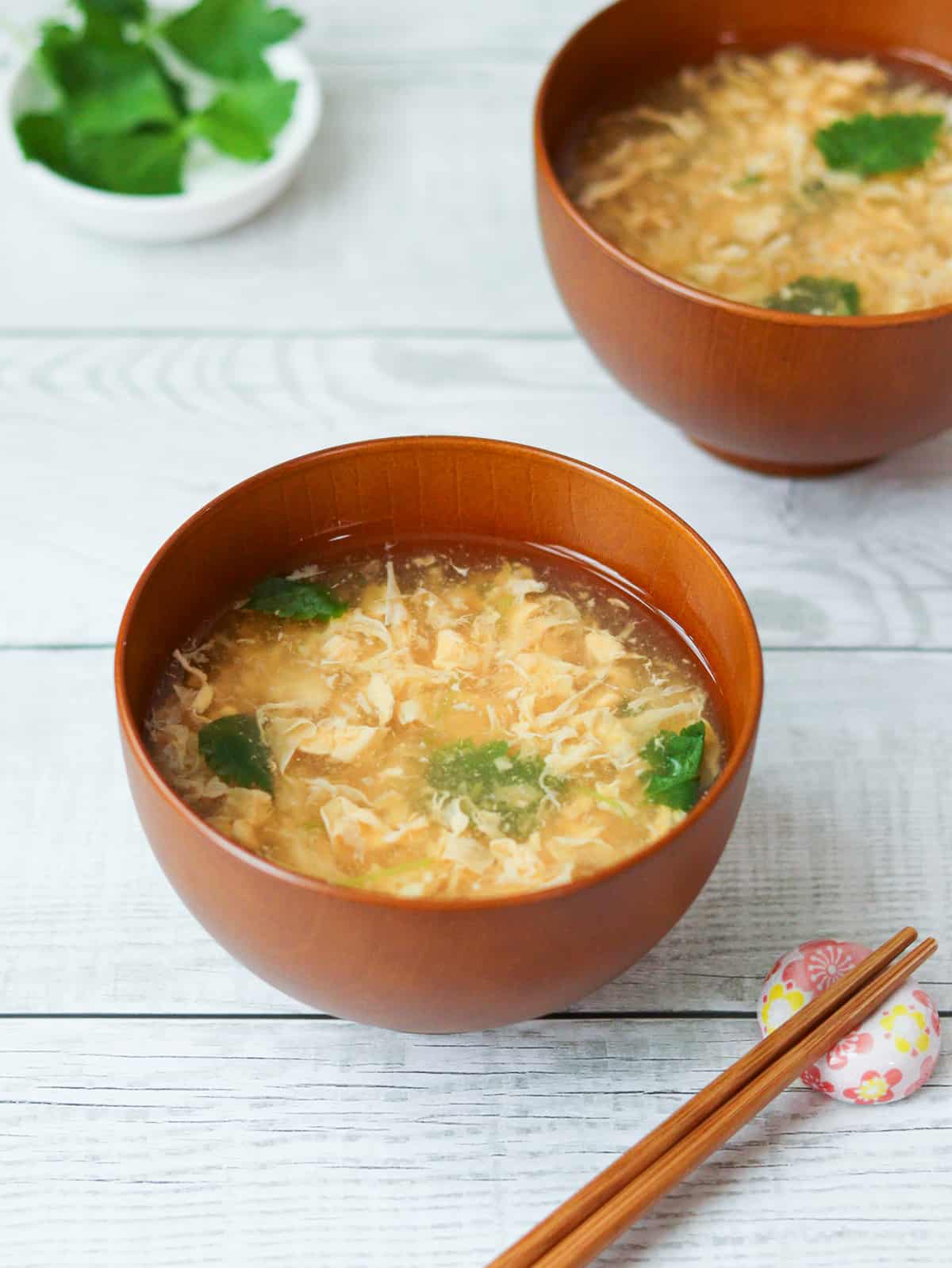
Jump to:
What is Kakitamajiru?
Kakitamajiru is a traditional Japanese soup made by thickening seasoned dashi broth with starch and adding beaten eggs. "Kaki" means to stir, "tama" is short for 'tamago,' meaning eggs, and "jiru" refers to soup.
While many people might associate Japanese soups with miso soup, learning to make this dish can expand your repertoire of Japanese soups. The combination of dashi and eggs pairs incredibly well, resulting in a delicious flavor.
Enhancing Umami Flavors of Dashi
The dashi broth typically used in making kakitamajiru is bonito dashi (awase dashi, which combines kombu dashi and bonito dashi, is also acceptable).
Bonito dashi contains an umami component called inosinic acid, while eggs, the primary ingredient of this soup, contain another umami component known as glutamic acid. These umami components are delicious on their own, but combining two (or more) different umami components is known to enhance their respective flavors and make them even more delicious through a synergistic effect. In other words, eggs and bonito dashi complement each other perfectly.
The combination of eggs and bonito dashi is a classic pairing found in various Japanese dishes such as Chawanmushi (savory egg custard) and Dashimaki Tamago (rolled omelet with dashi). It is so delicious that I highly recommend trying it in this recipe as well.
The recipe includes instructions on how to make bonito dashi, but if you would like to learn more, please refer to the linked page.
Ingredient Options
Kakitamajiru is a simple soup that primarily features the flavors of egg and dashi broth. Traditionally, it is enjoyed with just mitsuba (Japanese parsley) or green onions (scallions).
However, you can also enhance it with a variety of other ingredients. In Japan, chicken, carrots, onions, spinach, tofu, kamaboko (fish cake), shiitake mushrooms, enoki mushrooms, and wakame seaweed are sometimes added. A heartier version of this soup can be a modern and nutritious meal option. Feel free to experiment according to your preference.

📋Step-by-step recipe
Ingredients
- 1 egg
- 4 mitsuba (Japanese parsley)
- ½ tsp salt
- 1 tsp light soy sauce (Regular soy sauce can be used as a substitute; the main difference is the color.)
- ½ Tbsp potato starch or corn starch
- ½ Tbsp water (for the stach)
Bonito dashi:
- 2 cups water
- ½ cup bonito flakes (katsuobushi)
Instructions
🕒 Total: 10 minsIf you already have bonito dashi, start from step 3. In this case, use 1 ⅔ cups (400ml) of your dashi for 2 servings.
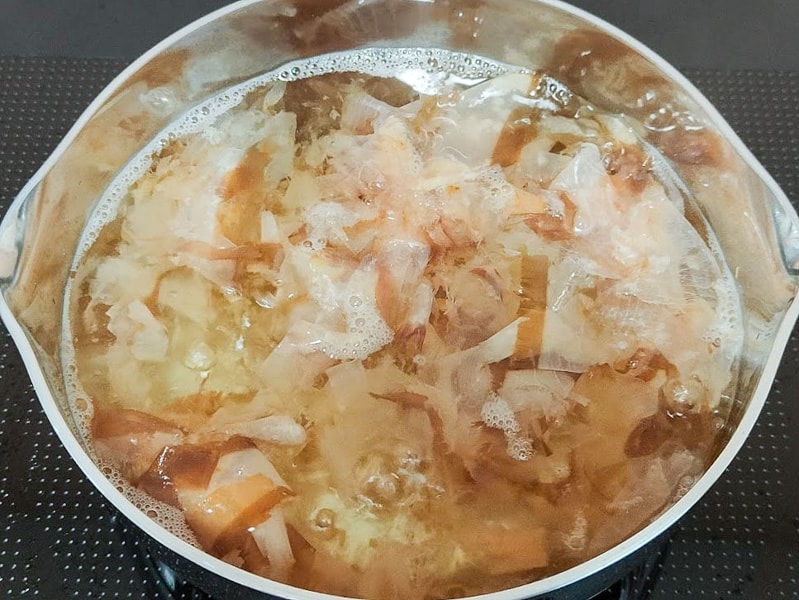
Step 1
Put water in a pot and bring it to a boil. Once boiling, reduce the heat to low, add bonito flakes, and let it simmer for 3 minutes.
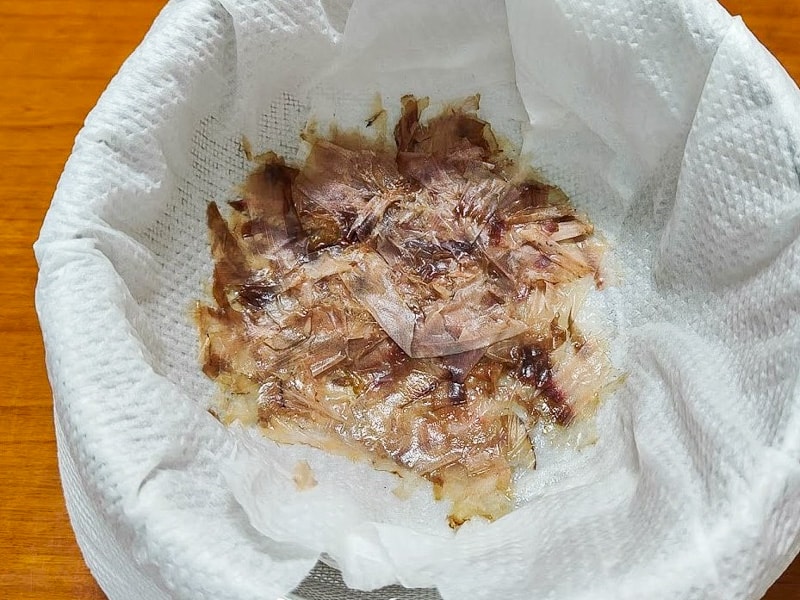
Step 2
Turn off the heat and strain the mixture through a sieve lined with paper towels or a cloth (such as cheesecloth). Alternatively, if you don't mind having some fine bonito flakes remaining, you can simply use a fine-mesh strainer. Bonito dashi is now ready.
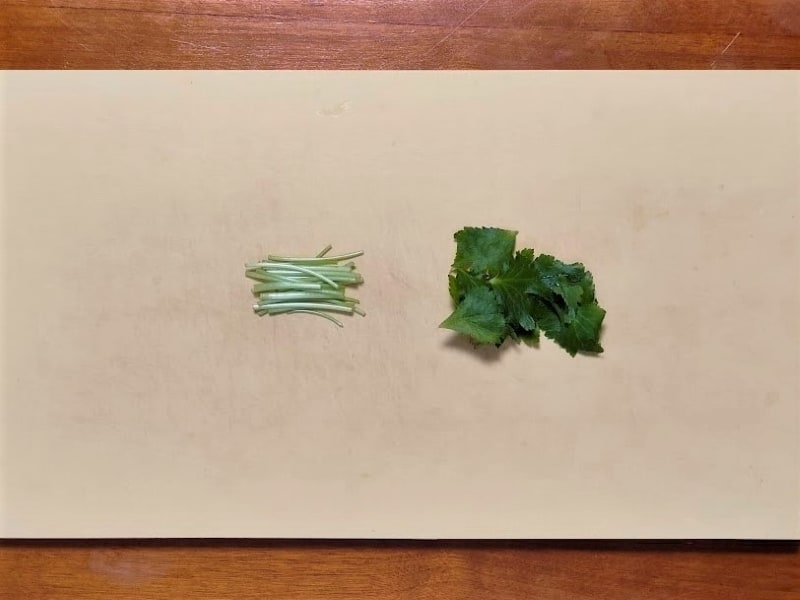
Step 3
Crack egg into a small bowl and beat it. Trim the base of mitsuba, separate the leaves, and cut the stems into ⅘-inch (2cm) pieces.
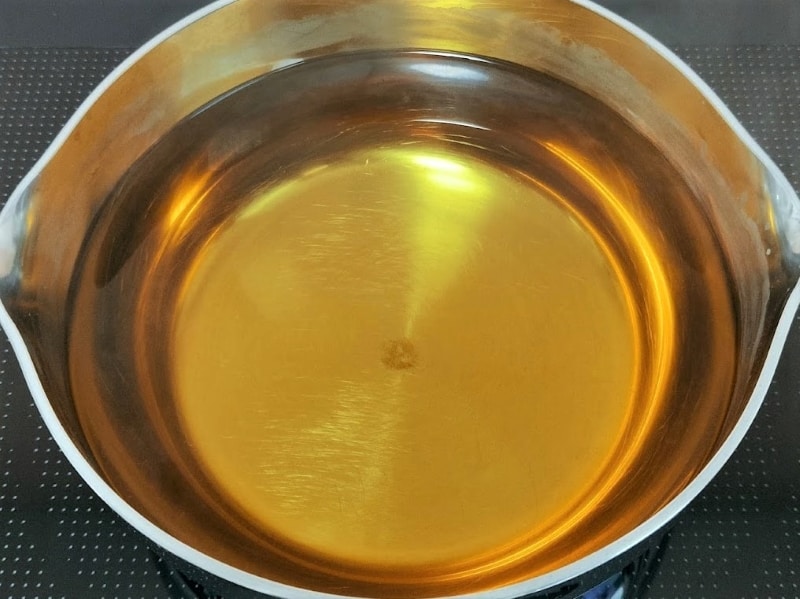
Step 4
Return the bonito dashi to the pot and bring it to a boil. Once boiling, reduce the heat to low, and add salt and light soy sauce.
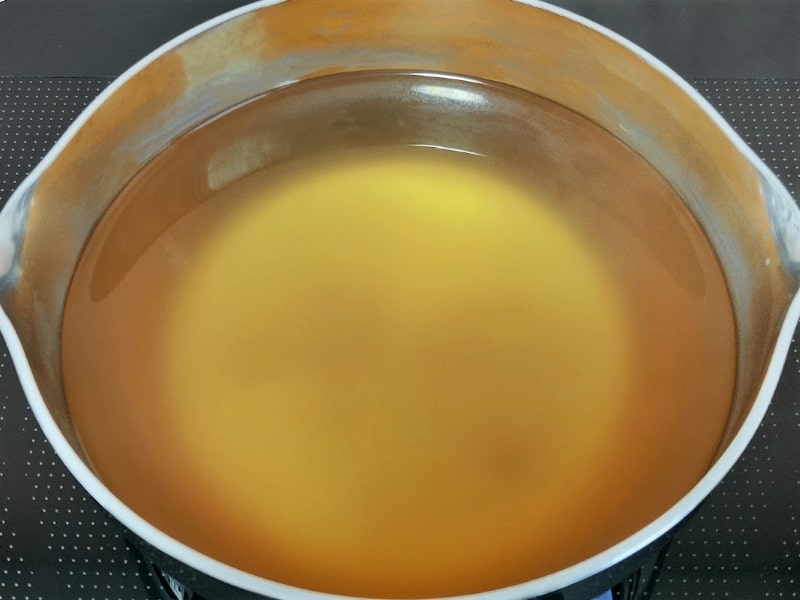
Step 5
Mix starch and water in a small bowl. Gradually add the dissolved starch to the pot, stirring to combine. Continue simmering briefly to eliminate the powdery texture of the starch.
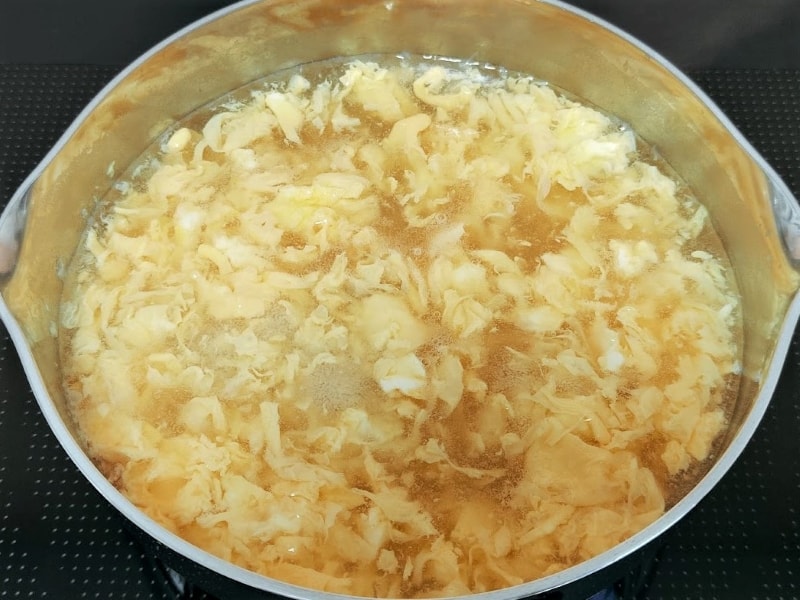
Step 6
Gradually pour the beaten egg into the pot, ensuring even distribution. Once you are certain the egg mixture has cooked, gently stir it.
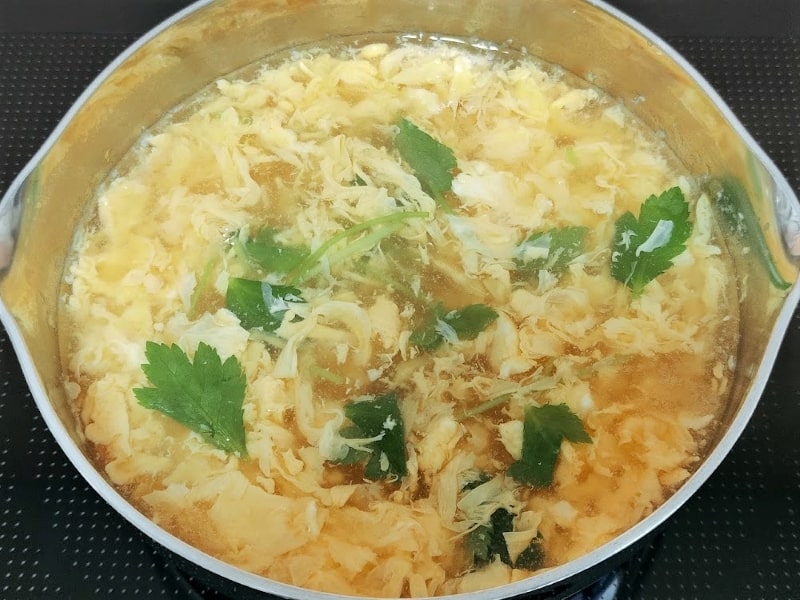
Step 7
Turn off the heat and then add the mitsuba leaves and stems.
To store
You can store it in the refrigerator for up to 2 days.
Tips on how to make
- Add starch dissolved in water to the dashi broth to thicken it. The thickened dashi will prevent the beaten egg from sinking to the bottom of the bowl, allowing it to float until it is time to eat.
- The beaten egg should be poured into the pan gradually and evenly. This will prevent the egg mixture from clumping together and create a fluffy texture. In Japan, it is common to pour the beaten egg gradually using a chopstick to let it trickle down.
- After pouring the beaten egg into the pot, make sure it has set before stirring. Stirring before the egg mixture has set can make the soup cloudy.
If you try this recipe, I’d love to hear what you think. Please consider leaving a review and star rating in the comments below. If you enjoyed it, I’d really appreciate it if you shared it with your friends.
Recipe card

Kakitamajiru (Japanese Egg Drop Soup)
Ingredients
- 1 egg
- 4 mitsuba (Japanese parsley)
- ½ tsp salt
- 1 tsp light soy sauce (Regular soy sauce can be used as a substitute; the main difference is the color.)
- ½ Tbsp potato starch or corn starch
- ½ Tbsp water (for the stach)
Bonito dashi:
- 2 cups water
- ½ cup bonito flakes (katsuobushi)
Instructions
- Put water in a pot and bring it to a boil. Once boiling, reduce the heat to low, add bonito flakes, and let it simmer for 3 minutes.
- Turn off the heat and strain the mixture through a sieve lined with paper towels or a cloth (such as cheesecloth). Alternatively, if you don't mind having some fine bonito flakes remaining, you can simply use a fine-mesh strainer. Bonito dashi is now ready.
- Crack egg into a small bowl and beat it. Trim the base of mitsuba, separate the leaves, and cut the stems into ⅘-inch (2cm) pieces.
- Return the bonito dashi to the pot and bring it to a boil. Once boiling, reduce the heat to low, and add salt and light soy sauce.
- Mix starch and water in a small bowl. Gradually add the dissolved starch to the pot, stirring to combine. Continue simmering briefly to eliminate the powdery texture of the starch.
- Gradually pour the beaten egg into the pot, ensuring even distribution. Once you are certain the egg mixture has cooked, gently stir it.
- Turn off the heat and then add the mitsuba leaves and stems.
Notes
- If you already have bonito dashi, start from step 3. In this case, use 1 ⅔ cups (400ml) of your dashi for 2 servings.
- You can store it in the refrigerator for up to 2 days.

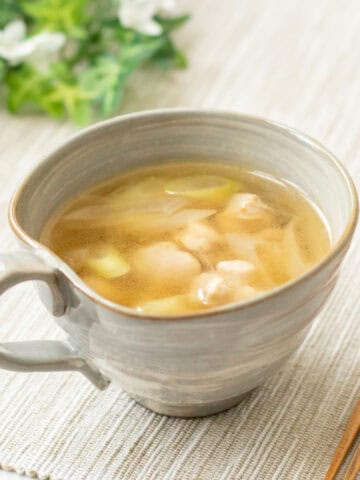

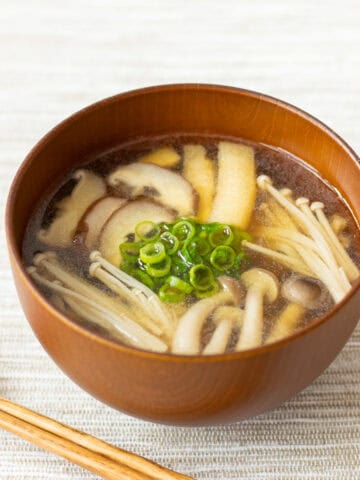
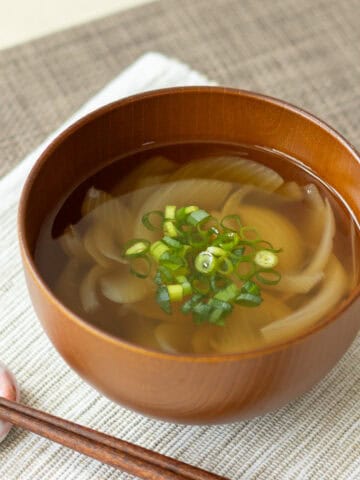
Leave a Rating and a Comment